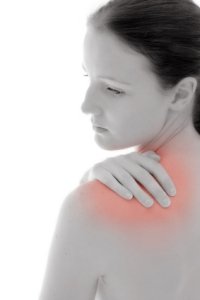|
Dislocated Shoulder
The shoulder joint is the most versatile joint in the human body, allowing for maximum range of movements packed with considerable power as well. It is without doubt the single most important joint in our day-to-day life, more so for sportspeople. The allowance for maximum range of movements has a pitfall as well. To permit such a wide range of movements, the glenoid cavity is designed to be shallow, with minimal actual contact surface between the head of the humerus (arm bone) and the glenoid cavity of the scapula (shoulder blade socket). The integrity of the joint in daily walks of life is due to the presence of rotator cuff tendons, which originate from the scapula and end in the head of the humerus encircling it from above, back and in front. They prevent the displacement of humeral head during normal movements of the shoulder joint. The rotator cuff is comparatively deficient on the front lower aspect of the humeral head, which is its Achilles Heel, predisposing it to dislocation. Shoulder dislocation can occur with any repetitive forceful movement, unexpected wrenching of the arm or a fall, displacing the humeral head from the glenoid cavity. Shoulder dislocation is different from shoulder separation. In shoulder separation, the injury occurs between the scapula and the clavicle (collar bone). The injury is to the Acromioclavicular joint (which is the joint between the acromion process of the scapula and the collar bone). So the term shoulder dislocation and separation should not be used synonymously. 
The predominant symptom of a dislocated shoulder is severe pain. Patient will feel increased pain with any attempt to move the injured shoulder. In addition, one may notice the loss of rounded contour of the shoulder. The hand is held immobile due to pain, the position of which differs according to the type of dislocation. There are 3 types of shoulder dislocation:
In anterior dislocation, the injured arm is held slightly away from the body with the palm facing the front. The deltoid contour of the shoulder is lost. The patient will not be able to touch the opposite shoulder and the dislocated head of the humerus can be felt below the collarbone. In posterior dislocation, the arm is held close to the body with the palm facing back. The deltoid contour of the shoulder is lost. The dislocated humeral head can be felt below the acromion process of the scapula. In inferior dislocation, the arm is held very much away from the body, with the patient preferring to keep his palm kept on or below the head by flexing his elbow. The dislocated humeral head is felt in the lateral chest wall. Whatever be the type of dislocation, the treatment of choice is painkillers, muscle relaxants and reducing the humeral head to its original position. However, this is often easier said than done! Putting the shoulder back in may require an anesthetic due to the muscle spasm and adhesion. The patient is continued on painkillers, kept in a sling and gradually encouraged to do home exercises. Subsequently the range of movements is increased over a few weeks to regain strength and stability. One troublesome problem with shoulder dislocation is the recurrence factor. If the first dislocation occurs within the age of 20, there is a 90% chance of recurrence however physiotherapy and a good strengthening programme will reduce the likelihood.
|




